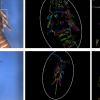Free Online Productivity Tools
i2Speak
i2Symbol
i2OCR
iTex2Img
iWeb2Print
iWeb2Shot
i2Type
iPdf2Split
iPdf2Merge
i2Bopomofo
i2Arabic
i2Style
i2Image
i2PDF
iLatex2Rtf
Sci2ools
CVPR
2009
IEEE
2009
IEEE
Dictionary-Free Categorization of Very Similar Objects via Stacked Evidence Trees
Current work in object categorization discriminates
among objects that typically possess gross differences
which are readily apparent. However, many applications
require making much finer distinctions. We address an insect
categorization problem that is so challenging that even
trained human experts cannot readily categorize the insects
based on their images. The state of the art that uses visual
dictionaries, when applied to this problem, yields mediocre
results (16.1% error). Three possible explanations for this
are (a) the dictionaries are unsupervised, (b) the dictionaries
lose the detailed information contained in each keypoint,
and (c) these methods rely on hand-engineered decisions
about dictionary size. This paper presents a novel,
dictionary-free methodology. A random forest of trees is
first trained to predict the class of an image based on individual
keypoint descriptors. A unique aspect of these trees
is that they do not make decisions but instead merely rec...
| Added | 09 May 2009 |
| Updated | 10 Dec 2009 |
| Type | Conference |
| Year | 2009 |
| Where | CVPR |
| Authors | Andrew Moldenke, Asako Yamamuro, David A. Lytle, Eric N. Mortensen, Gonzalo Martínez-Muñoz, Linda G. Shapiro, Nadia Payet, Natalia Larios Delgado, Robert Paasch, Sinisa Todorovic, Thomas G. Dietterich, Wei Zhang |
Comments (0)

